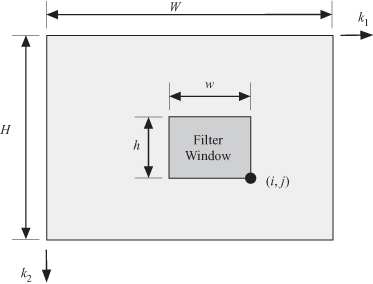13.2 LINE AND FRAME WRAPAROUND PROBLEMS
There is an inherent problem in processing raster-scanned images: line and frame wraparound. Consider 2-D filters for an image. Figure 13.1 shows the main system parameters for a 2-D first-quadrant digital filter. The image being processed has a width of W pixels and a height of H pixels. The 2-D filter window width is w pixels and the height is h pixels. The axes are as shown since typically, lines are numbered starting from the top. The output sample at location (i, j) is indicated by the dark circle and is obtained by processing all the pixels in the dark gray area shown.
Figure 13.1 System parameters for a 2-D digital filter.

Figure 13.2 shows the different locations of the filter window as it scans the image to produce the processed image as an output. Output pixel a in Fig. 13.2 shows the case when the output sample lies in the first row. The window buffer of the filter is mostly empty except for the input data shown as the shaded region in the window area. Output pixel b in Fig. 13.2 shows the case when the output sample is the last pixel in the first row. Now the filter moves to produce the first pixel in the second row as shown in the figure by point c. The valid input data are shown by the dark shaded area. The stipple pattern shows the data remaining in the filter due to scanning output b. The correct output c should have been ...
Get Algorithms and Parallel Computing now with the O’Reilly learning platform.
O’Reilly members experience books, live events, courses curated by job role, and more from O’Reilly and nearly 200 top publishers.

